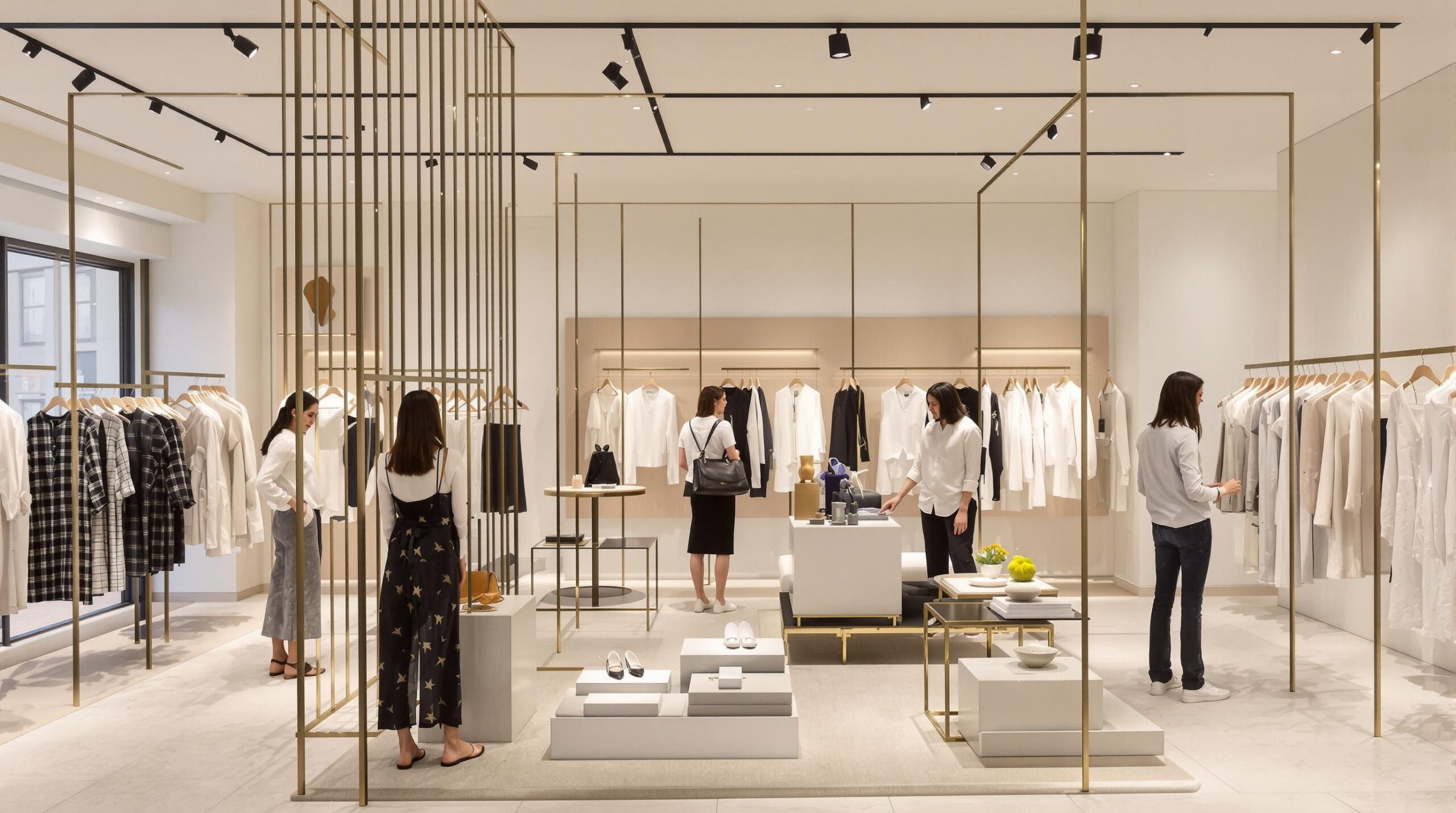Minimalist fashion emphasizes simplicity, subtle elegance, and timeless appeal. Unlike ever-changing fashion trends, minimalism’s focus on quality is enduring. Increasingly, it has captured the attention of luxury consumers worldwide. Clean lines, classic cuts, and muted tones define minimalist fashion. This aesthetic starkly contrasts more ostentatious designs traditionally associated with luxury fashion.
The Appeal of Minimalist Fashion in Luxury
The luxury market’s attraction to minimalist fashion originates from its essence of understated sophistication. Minimalist pieces, unlike other luxury trends, prioritize quality over ornamentation. Classic, refined, and discreet pieces appeal to luxury consumers who value longevity. High-quality materials and exquisite craftsmanship ensure minimalist garments endure in style and substance.
Discerning consumers are attracted to minimalism’s versatility and elegance. Versatile pieces allow wearers to maximize their wardrobe with fewer items. Like a perfectly tailored blazer, investment pieces enhance many outfits. The commitment to versatility aligns with luxury consumers’ desire for practical yet stylish solutions.
Lifestyle Shifts Towards Simplicity
Changes in lifestyle preferences have fueled minimalist fashion’s rise in luxury markets. Many consumers are adopting simpler, clutter-free living choices. Minimalism extends beyond fashion; it represents a broader lifestyle approach. People appreciate the value of fewer items that provide greater satisfaction and usability.
Living space trends also reflect this minimalist mindset. Larger, more luxurious urban domiciles increasingly feature sleek, minimal designs. Fashion follows suit, representing broader cultural tendencies that spread across various sectors. The shift toward sustainable living and more straightforward aesthetics has become increasingly popular among luxury consumers.
Sustainability and Ethical Considerations
Sustainability is a fundamental pillar of minimalist fashion. Designs prioritize reducing waste and using environmentally responsible materials. Increasing consumer awareness has led to greater demand for sustainable fashion. Ethical considerations now play a much more significant role in purchasing decisions for luxury fashion consumers.
Luxury brands are responding by reducing waste and optimizing production processes. This shift challenges traditional fashion cycles, focusing instead on thoughtful, measured production. Minimalist fashion uses durable, sustainable materials to minimize environmental impacts. This approach resonates with consumers who value ecological consciousness and responsibility.
Luxury Brands Embracing Minimalism
Luxury brands are increasingly integrating minimalist principles into their collections. Notable designers champion the minimalist movement, bringing subtle designs to high fashion. Renowned houses like Hermès, The Row, and Jil Sander have long embraced minimalist aesthetics. Recently, even prominent brands like Gucci and Balenciaga have subtly incorporated minimalism.
These designers focus on precision, excellence, and craftsmanship in minimalist collections. They produce pieces characterized by lasting materials, muted color palettes, and elegant silhouettes. As more luxury brands embrace minimalism, they redefine high fashion norms, opening doors for more minimalist pioneers to thrive within the luxury market.
Minimalism as a Status Symbol
Amid the changing landscape, minimalist fashion has become a unique status symbol of sophistication. Wealthy consumers demonstrate their status through understated elegance, not conspicuous consumption. Minimalism’s focus on quality and subtlety appeals to those who prefer less obvious displays of affluence.
The preference for subtle luxury speaks to a refined taste that values artistry and craftsmanship over logos. A minimalist outfit emphasizes quietly luxurious aspects like fabric quality, workmanship, and fit. These factors convey sophistication and discernment without relying on flashy embellishments or branding. This nuanced expression of status attracts connoisseurs who appreciate less-is-more philosophies.
Digital Influence on Fashion Trends
The digital revolution significantly influences fashion, altering how consumers engage with brands. Online platforms promote minimalist styles, bringing them to a broader audience. Influencers and bloggers embrace minimalism, showcasing it through social media channels. Their reach extends to luxury consumers seeking inspiration from respected style icons.
Digital platforms encourage minimalists to follow a streamlined, more straightforward fashion narrative. Shopping apps and websites highlight minimalist fashion’s appeal, offering curated selections prioritizing quality. As digital strategies promote minimalism in fashion, they encourage luxury consumers to adopt this refined, enduring aesthetic.
Changing Demographics in Luxury Goods
Shifting demographics contribute to minimalist fashion’s ascent in luxury markets. Millennials and Generation Z prioritize experiences, quality, and authenticity. As these consumers gain purchasing power, their preferences shape the evolution of luxury fashion. Younger buyers value sustainability, craftsmanship, and ethically produced goods, all key elements of minimalist fashion.
These generations prefer timeless pieces that coexist with the fast-paced digital environment. Their interest in authenticity creates demand for brands that embrace minimalist principles. Brands responding to these demographic changes will likely capture this growing segment of luxury consumers.
Minimalism’s Impact on Brand Identity
Embracing minimalist fashion can significantly impact a brand’s identity. Many well-established luxury brands are evolving, incorporating minimalist elements without neglecting their heritage. Balancing these elements fosters innovation while maintaining brand integrity.
A minimalist approach can redefine a luxury brand’s personality, aligning with contemporary consumer values. It revitalizes a brand’s image, ensuring greater relevance and distinction in crowded luxury markets. Integrating minimalism allows brands to maintain traditional luxury while embracing modern trends.
Future of Minimalist Fashion in Luxury Markets
The future of minimalist fashion within luxury markets looks promising. Minimalism’s focus on sustainability and longevity sets it apart from fleeting trends. Driven by consumer demand, luxury brands are likely to incorporate even more minimalist designs.
Innovation within the minimalist space may lead to new opportunities for luxury brands. Emphasizing materials that balance luxury with eco-friendliness will become increasingly important. As consumer awareness grows, brands must uphold these principles as a benchmark. Minimalist fashion encourages thoughtful design and craftsmanship, promising lasting appeal within luxury circles.
Conclusion
Minimalist fashion transforms luxury markets by prioritizing simplicity, quality, and timeless appeal. Its rise signals a shift in consumer values towards sustainable, versatile, and ethically conscious designs. This movement reshapes the luxury fashion landscape, challenging traditional norms. By embracing minimalism, luxury consumers express a sophisticated and modern aesthetic.
To thrive, luxury brands must embrace this minimalist wave. Integrating minimalist principles meets evolving consumer expectations, ensuring their enduring appeal. As minimalism continues defining modern luxury, it promises an era where simplicity becomes the ultimate form of sophistication.

